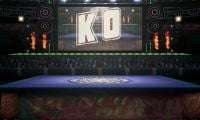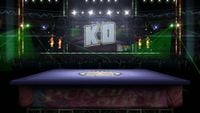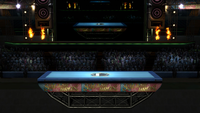| Welcome to SmashWiki! Log in or create an account and join the community, and don't forget to read this first! |
| Notices |
|---|
| The Skill parameter has been removed from Smasher infoboxes, and in its place are the new "Best historical ranking" and "Best tournament result" parameters. SmashWiki needs help adding these new parameters to Smasher infoboxes, refer to the guidelines here for what should be included in these new parameters. |
| When adding results to Smasher pages, include each tournament's entrant number in addition to the player's placement, and use the {{Trn}} template with the matching game specified. Please also fix old results on Smasher pages that do not abide to this standard. Refer to our Smasher article guidelines to see how results tables should be formatted. |
| Check out our project page for ongoing projects that SmashWiki needs help with. |
Boxing Ring
| Boxing Ring | |
|---|---|
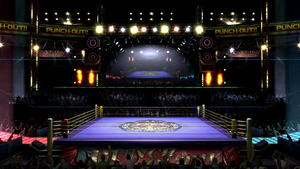 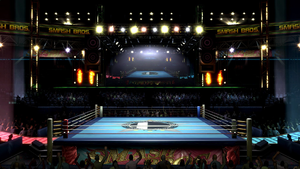 Boxing Ring in Super Smash Bros. Ultimate. 
| |
| Universe | Punch-Out!! |
| Appears in | SSB4 Ultimate |
| Availability | Starter |
| Crate type | Normal |
| Maximum players | 4 (3DS and Wii U) 8 (Ultimate) |
| Tracks available | In SSB4: 3DS version: Jogging / Countdown Minor Circuit (Alternate) Wii U version: Jogging/Countdown Minor Circuit Minor Circuit Title (Punch-Out!!) World Circuit Theme Culdcept Shin Onigashima Medley Tomorrow's Passion In Ultimate: Jogging / Countdown Minor Circuit Minor Circuit World Circuit Theme Title Theme - Punch-Out!! (Wii) Ken Stage (when unlocking Ken) The Battle at the Summit! (when unlocking Incineroar) |
| “ | Punch-Out!! is the inspiration for this stage. You're able to fight both inside the ring and out. Try using the ropes on the left and right of the ring to perform giant jumps, or attack the light fixture above the ring to send it crashing down. | ” |
| —Super Smash Bros. 4 Official Site | ||
| “ | You can jump really high using the ringside rope. And when you attack the lights on the ceiling…well, you'll have to wait and see. By the way, holding down the L button when selecting this stage will turn this into the Punch-Out!! version of the Boxing Ring! | ” |
| —Super Smash Blog, Super Smash Bros. Ultimate Official Site | ||
Boxing Ring (特設リング, Special Ring) is a stage in both versions of Super Smash Bros. 4 and in Super Smash Bros. Ultimate. This stage is set in the World Circuit boxing ring from the Punch-Out!! series.
Stage overview
The boxing ring lies inside of an indoor stadium. An overhead light fixture hangs above the ring, along with a jumbotron in the background with large speakers astride of it. The stadium additionally features various lights, green krypton lasers, background pyrotechnics, fog machines along the entrance platforms, a scrolling LED panel hanging around the walls, and a visible audience surrounding the entirety of the ring.
Both sides of the stage feature sloped entrance platforms that incline downwards towards the ring. Players can spring off of the ropes strung around the left and right sides of the ring. These ropes can also be used to reach the light fixture hanging above. This light fixture can be stood on and even damaged to the point of it dropping down into the ring and breaking, consequently dimming the lighting of the stadium. It can deal damage on the way down and may potentially KO players who have high damage percentages. The light fixture can take about 64% before it comes crashing down. The lower blast line is normally inaccessible in this stage.
The jumbotron displays the action in the ring. Both the surrounding scrolling LED panel and jumbotron display "KO!" when a character scores a KO, (does not happen on Local Wireless of the 3DS version) and "SUDDEN DEATH" during Sudden Death for the remainder of the match. When the Smash Ball appears, the scrolling text says "CHANCE!" instead of "PUNCH-OUT!!" or "SMASH BROS." In Super Smash Bros. for Wii U and Ultimate, the screen can display a versus splash with unique titles for the character shown, a character's KO and damage totals, and the match timer. If the battle is not timed, the time display will have dashes in place of numbers. The screen also shows "Fight #". This number actually refers to what number the match played is. If the match number is 10 or more, it will just display "Fight #9". It resets every time the game is turned on. When playing online, it's random. The last thing the jumbotron will display is the current leader of the match, displayed by the "TOP" area in the versus splash screen, such as "TOP - KIRBY". If two or more characters are tied in points, stocks or coins, the display will instead read "TOP -". Additionally, the leader's KO total and position can also be briefly be seen during the time the jumbotron displays "KO!".
There are two aesthetic variants to this stage: one is the standard Punch-Out!! World Circuit boxing ring, and the other has a Super Smash Bros. motif. While each variant of the stage is chosen at random, players can also manually choose which variant of the stage they would like to play on at the stage select screen. The standard Punch-Out!! version can be chosen by selecting the stage while holding the Y button in Super Smash Bros. for Nintendo 3DS or the ZR button in Super Smash Bros. for Wii U. The Super Smash Bros. variant can be chosen by selecting the stage while holding the L button in Super Smash Bros. for 3DS or the ZL button in Super Smash Bros. for Wii U.
Ω forms and Battlefield form
In Super Smash Bros. 4, both the Punch-Out!! and Super Smash Bros. boxing rings are available in the Ω form. There are no ropes around the ring, the foreground audience is missing, and the light fixture cannot be reached.
In Super Smash Bros. Ultimate, the Ω form and Battlefield form are similar to SSB4's Ω form; however, the main platform is slightly redesigned and is resized and reshaped to match Final Destination and Battlefield, respectively. The three soft platforms of the Battlefield form resemble the colored light floors of the regular form.
Origin
In every home console Punch-Out!! game, the player plays as Little Mac as he works his way up in professional boxing circuits to become the W.V.B.A. (World Video Boxing Association) champion. The Punch-Out!! variation of this stage is loosely based on the Major Circuit stadium's interior design, which features a lot of bluish designs and furniture, and the World Circuit's boxing ring, which has a blue mat with the World Circuit's logo in the center and yellow ropes. Both of these designs appear in Punch-Out!! for the Wii, though the text displays "Punch-Out!!" rather than "Major Circuit" or "World Circuit," and the walkways leading to the ring are largely absent in the game itself. The jumbotron hanging above the ring is taken from the Punch-Out!! arcade game, though in addition to displaying player stats like in said game, it also shows the action from the ring in real-time. The Major Circuit is the second circuit in the game, where Little Mac must fight Piston Hondo, Bear Hugger, Great Tiger and Title Holder Don Flamenco. The World Circuit is the final circuit in the game and has Little Mac fight against Aran Ryan, Soda Popinski, Bald Bull, Super Macho Man and the reigning champion, Mr. Sandman. After beating the game in Contender mode, Little Mac must fight off tougher versions of his past opponents in the World Circuit ring in Title Defense mode.
Tournament legality
The stage is usually banned because the hanging lights can drop and cause early KOs to even heavier characters. The stage also has walk-offs which can promote camping.
Character titles
In Super Smash Bros. 4
In Super Smash Bros. Ultimate
Gallery
Super Smash Bros. for Nintendo 3DS
Super Smash Bros. for Wii U
Little Mac on the Boxing Ring.
Sudden Death on the jumbotron and on the surrounding scrolling LED panel.
Super Smash Bros. Ultimate
Bowser Jr. dueling Villager on the stage in Ultimate.
Donkey Kong posing on the stage.
King K. Rool posing on the stage.
Little Mac getting slammed by Pikachu’s down throw on the stage.
Character title references
- Luigi: The NA character title for Luigi is a reference to his Super Smash Bros. unlock notice: "You can now use Luigi, the eternal understudy."
- Peach: The NA character title for Peach is a reference to her original localized name until 1996, "Princess Toadstool".
- Bowser: The PAL French character title for Bowser is a pun of pronunciation with the name of the Koopas.
- Dr. Mario: The PAL Spanish character title for Dr. Mario is a reference to the Spanish group Jarabe de Palo.
- Larry: The PAL character title for Larry describes him as the leader of the Koopalings as a result of an out-of-context translation of his Japanese title, "Boss Minion", meaning that he is a minion among bosses being the youngest Koopaling. This also references how Larry is usually the first to be fought, essentially "leading" the charge.
- Yoshi: The PAL French character title for Yoshi is a pun of pronunciation with the names "œufs" (eggs) and "yeux" (eyes).
- Diddy Kong: The PAL French character title for Diddy Kong is a pun with a popular French rhyme "Il était un petit homme" (literally "He was a little man") written by Gabrielle Grandière.
- Sheik: The Spanish character title for Sheik uses the male word for "warrior".
- Sheik: The PAL French character title for Sheik is a wordplay with the name of the "Sheikah" and the French "Qui c'est qu'à [...]" (means "Who does [...]) which share similar pronunciation.
- Ridley: Ridley's title is a reference to a title he was given on the official Japanese website of Metroid: Zero Mission, 狡猾の死神 (Cunning God of Death).
- Kirby: Kirby's Japanese title in SSB4, and international title in Ultimate, is a reference to the in-game description for The Arena in Kirby Super Star, which calls him a "pink demon" in the Japanese script. This was translated as "the Pink Wonder" in the original SNES version's English script and "the pink terror" in Kirby Super Star Ultra's English script. The English title in Ultimate matches Kirby: Planet Robobot's in-game description for its version of The Arena, which calls Kirby "the pink demon".
- King Dedede: The PAL French character title for King Dedede is a pun with "marteau" in French which means "crazy" and "hammer". The English title in Ultimate is a reference to Kirby Star Allies's in-game description for him during Guest Star ???? Star Allies Go!, which calls King Dedede a "self-made king".
- Fox: The PAL character title for Fox is a reference to a recurring line in the Star Fox franchise: "Never give up. Trust your instincts."
- Fox: The Dutch character title for Fox references Peppy Hare's infamous quote from Star Fox 64, "Do a barrel roll!"
- Pikachu: The PAL French character title for Pikachu is a pun with "survolté" which is composed of the word "volt" and means "overexcited".
- Mewtwo: The character titles for Mewtwo reference the title of the movie, Pokémon the Movie: Genesect and the Legend Awakened.
- Pokémon Trainer: The NA character title for Pokémon Trainer refers to the first line of the anime's theme song: "I want to be the very best."
- Lucas: The NA and PAL character titles for Lucas are a play on the name of his hometown: Tazmily Village on the Nowhere Islands.
- The PAL character title is also a reference to the Tasmanian devil.
- The character title in Super Smash Bros. Ultimate references his introductory tagline in Super Smash Bros. 4.
- Marth: In every language, Marth's character title is based on the honorific "Hero-King" epithet given to him in the timeline seen in the best ending of Fire Emblem: Mystery of the Emblem. He is also frequently referred to by this title in later games and spinoffs.
- Roy: In every language, the character title for Roy is the epithet given to him in the character ending sequence of Fire Emblem: The Binding Blade. He is also frequently referred to by this title in later games and spinoffs.
- Ike In every language, Ike's character title is the epithet first given to him in the epilogue of Fire Emblem: Radiant Dawn. The epithet only originally appeared in the Japanese version of Radiant Dawn, having been skipped over in all localizations of the game, but entered regular use in all languages from Awakening onward.
- Lucina: The Japanese character title for Lucina is her epithet in the epilogue of the Japanese version of Fire Emblem Awakening, and is also the title of that game's sixth chapter, which heavily features her. In both cases, the English version of Awakening translated this as "Foreseer". She also goes by this epithet in the Japanese version of Fire Emblem Heroes, translated as "Future Witness" in that game's English releases.
- Villager: All but the Japanese titles for the Villager reference how the Villager is the mayor of their city in Animal Crossing: New Leaf.
- Shulk: The Japanese character title for Shulk is a reference to one of his recurring text-only quotes in the Japanese Xenoblade Chronicles script, "穏やかじゃないですね", which has a different meaning (e.g. "You sure aren't peaceful" or "How exciting") depending on context.
- Inkling: The Japanese character title for Inkling is a wordplay on いかす (ikasu, meaning stylish, fresh) and イカ (ika, meaning squid).
- Snake: The NA character title for Snake is a title given to both Solid Snake and Big Boss, fittingly matching Snake's own hybrid appearance in his Smash design.
- Sonic: The NA character title for Sonic is a reference to one of his common nicknames, while the PAL character title is a reference to one of his victory pose quotes in Brawl: "Sonic's the name, speed's my game!"
- Mega Man: The Japanese and pre-Ultimate NA character titles for Mega Man are references to Mega Man 8's full Japanese title, Rockman 8: Metal Heroes. The PAL and Ultimate NA character titles are a reference to Mega Man's official English nickname.
Trivia
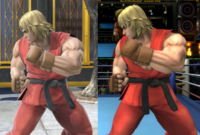
- In Ultimate, Boxing Ring has a unique visual shader that changes the appearance of the fighters. This shader saturates their colors, making them look more cartoony. This is likely a reference to Punch-Out!! (Wii)'s cel-shaded art style.
- Link, Kirby, King Dedede, Mega Man, and Ryu are the only veterans to have their titles changed in the English localization of Ultimate.
- Charizard also loses its unique title in all versions, as it is part of the Pokémon Trainer in Ultimate.
| show Stages in Super Smash Bros. 4 |
|---|
| show Stages in Super Smash Bros. Ultimate |
|---|
| show
|
|---|


